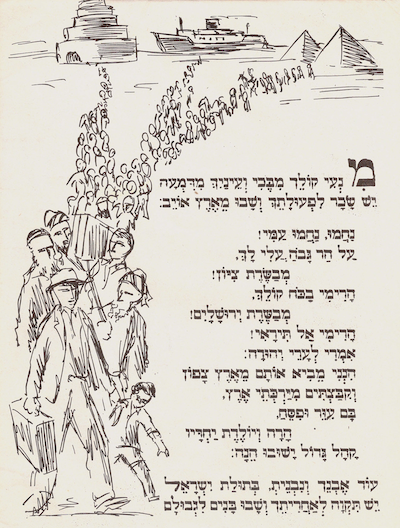This introduction appears in In Every Generation: A Haggadah Supplement for 5784, recently published by the Shalom Hartman Institute (hartman.org.il).
The injunction, “Bekhol dor vador chayav adam lir’ot et atzmo keilu hu yatzah mimitzrayim,” “In every generation, each person is obligated to see themselves as if they had participated in the Exodus from Egypt,” is one of the most evocative lines in the Haggadah. It is a call to empathy, to feel the suffering and redemption of our ancient ancestors as our own. It is also a command to use the story to bring meaning into our own contexts, as we imagine ourselves being lifted out of despair and into freedom.
Every year, we see ourselves in this story in a different way – this is part of what makes the seder such a lasting and powerful ritual. This year, the reverberating trauma of Oct. 7, ongoing war in Gaza, thousands of Israelis displaced from their homes, rising antisemitism and weakening bonds of allyship around the world give us new lenses for understanding the Exodus story. In some cases, the words of the Haggadah feel more relevant; in others, the Haggadah’s proclamations clash with reality. How can we celebrate a holiday of freedom when more than 100 people are still held captive in Gaza? How do we call for all who are hungry to come eat at our tables when so many Israelis are not at their own seder tables and millions of Palestinians are on the brink of famine?
While there are no definitive answers to these questions, the Shalom Hartman Institute of North America has developed : A Haggadah Supplement for 2024, a collection of readings, essays and questions inspired by The Israeli Haggadah: Special Edition (Hebrew, 2024) by Mishael Zion and Noam Zion, celebrating the 20th anniversary of their 2004 Israeli Haggadah, later released in English as A Night to Remember: The Haggadah of Contemporary Voices. We encourage you to read In Every Generation as you prepare for the holiday and then to bring it to your seder table … to re-enter a generation-spanning conversation and envision ourselves anew in the Exodus story’s themes of persecution, resilience and redemption.
After Oct. 7, Mishael Zion began collecting and reading haggadot from the founders of the kibbutzim next to Gaza, finding strength in their determination and in the contemporary resonance of their additions to the Haggadah. He writes, “Reading their words, I was reminded that the power of the Exodus is not only in the covenant of common fate that we forged, but also a covenant of destiny…. It affirms that in every generation we can, and we must, change history.”
These haggadot include one created by founding members of what would become Kibbutz Be’eri, one of the kibbutzim in the Gaza Envelope that was attacked on Oct. 7, 2023. The nascent group related to the Exodus story of suffering and redemption and, like generations of Jews before and since, they added new layers to the ancient texts, recording their aspirations for their new community through supplemental texts and illustrations. As Yigal Zorea describes in Lines and Dots, his blog about Kibbutz Be’eri, several years after that first Passover, the kibbutz members hired designer Paul Kor to embellish their initial efforts. The image [on this page] comes from the end of Kor’s version of the Haggadah. It depicts groups from ancient history, including those scattered from the Tower of Babel, the Israelites enslaved in ancient Egypt and the ma’apilim arriving in the land of Israel during the British Mandate period, all arriving and merging into one collective at Kibbutz Be’eri, where they receive comforting verses from the prophets, affirming that their hardship will be rewarded and the Jewish people will be gathered together once more.

The people who created the Kibbutz Be’eri Haggadah were in the early stages of building a safe and self-sustaining home in the desert, and their conditions were precarious. The Passover’s story of biblical enslavement and salvation served as the foundation for their own resilience. Their Haggadah is just one example from a rich history of Jews adapting the framework of the Haggadah to suit their contexts and to foster meaningful contemporary conversations. Many kibbutzim across Israel still make their own haggadot for Passover, timelessly drawing on the same hopes and questions that the founders of Kibbutz Be’eri included in 1946. But this year, six months after the kibbutz communities of the Gaza Envelope were attacked, it is particularly powerful to bring voices from these kibbutzim – their worry and their optimism – into our seder conversations, preserving this history of storytelling, even as the buildings and communities they built stand empty this Passover.
We invite you to use some or all the materials from In Every Generation to bring contemporary questions to an ancient ritual and story, and we encourage you to invite guests to bring their own supplemental materials, too. Like the founders of Kibbutz Be’eri, who created a Haggadah depicting the lush fields that surrounded them and quoting biblical texts, we hope the resources of In Every Generation will help you tell the story of the Exodus in a way that reflects the values, challenges and aspirations of Jews today. The supplement includes excerpts from kibbutz haggadot; essays on understanding and responding to the “wicked child”; pieces on the role of hope in Jewish history and in the present; and more.
This year, when we say “leshana haba’ah beyerushalayim,” “next year in Jerusalem,” may we do so with the intention and prayer that, next year, Jerusalem will be at peace. To download In Every Generation, visit hartman.org.il.
Rabbi Jessica Fisher is the director of rabbinic enrichment at the Shalom Hartman Institute of North America.
